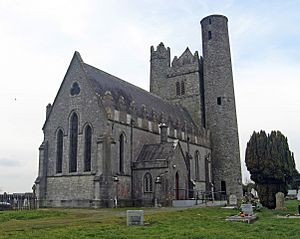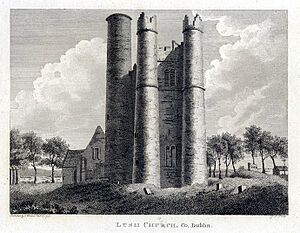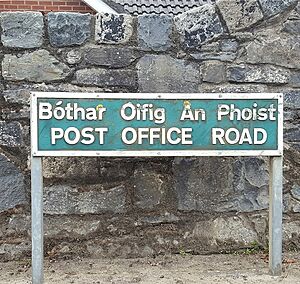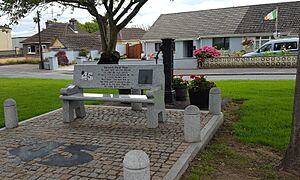Lusk, Dublin facts for kids
Quick facts for kids
Lusk
Lusca
|
|
|---|---|
|
Town
|
|

Church of Ireland and round tower at Lusk
|
|
| Country | Ireland |
| Province | Leinster |
| County | County Dublin |
| Local government area | Fingal |
| Elevation | 25 m (82 ft) |
| Population
(2022)
|
|
| • Total | 8,806 |
| Time zone | UTC±0 (WET) |
| • Summer (DST) | UTC+1 (IST) |
| Eircode routing key |
K45
|
| Telephone area code | +353(0)1 |
| Irish Grid Reference | R746888 |
Lusk (Irish: Lusca) is a town located just north of Dublin, Ireland. It is about 20 kilometres (12 miles) from Dublin city centre. Lusk is part of a larger area called Fingal in County Dublin.
Contents
What's in a Name? The History of Lusk
The name "Lusk" comes from an old Irish word, Lusca. This word means 'cave' or 'underground chamber'. It is believed that Saint MacCullin founded a church here around the year 450 AD. People say he might have lived or been buried in a cave, which gave the town its name. Saint MacCullin died around 497 AD.
Before Christianity, this area was known as Bregia. It was famous in Irish myths as the birthplace of Emer, the wife of the legendary hero Cú Chulainn.
Lusk's Past: From Vikings to Today
Lusk has a long and interesting history. Saint MacCullin has been linked to the area since about 450 AD. Another saint, St. Maur, is also connected to this region.
In the 8th and 9th centuries, Vikings often attacked and burned Lusk. Eventually, these Vikings built a lasting settlement in Dublin.
The Famous Round Tower
The most important old building in Lusk is the round tower. It was built between the 10th and 11th centuries. This tower is next to a square tower built by the Normans in the 15th century. The square tower has three smaller towers at its corners. Inside, you can find old tombs from the Middle Ages.
The round tower stands 27 metres (89 feet) tall. It used to be even taller! It has nine floors inside, which is more than most round towers. Each floor has windows for light. The top of the tower used to have a cone-shaped roof, but now it has a flat wooden roof.
Churches and Community
The Church of Ireland church in Lusk was built in 1847. It was designed in an Early English Gothic style. If you look closely at the building, you might spot a stone image of St. MacCullin's face.
In 2016, a new, modern post office opened in Lusk. This helped the growing number of people living in the area.
Growing Population of Lusk
For most of the 1900s, Lusk's population stayed about the same. However, in the early 2000s, the town started to grow very quickly. Many people moved to Lusk from Dublin city, other parts of Europe, Africa, and Asia.
Between 2001 and 2006, more than half of all homes in Lusk were built. The population more than doubled in that time, from about 2,500 to over 5,200 people. By the 2022 census, Lusk had a population of 8,806.
Things to Do in Lusk: Amenities and Clubs
Lusk has several schools for children. There are four national (primary) schools: Lusk NS, Hedgestown NS, Corduff NS, and Rush and Lusk Educate Together NS. For older students, Lusk Community College opened in 2013.
Community Spirit
The Lusk Community Council Ltd (LCC) is a group of volunteers. They help manage local buildings like the Carnegie Library hall and the Old Church Hall. They also organise the St Patrick's Day parade every year. In 2022, they opened the Lusk Community Cultural Centre, which hosts art shows and other events.
Lusk is home to many social clubs and activities:
- Lusk Community Cultural Centre
- Lusk United AFC (a soccer club)
- the Round Towers GAA club (for Gaelic games)
- a branch of the Irish Countrywomen's Association
- an athletics club
- a local heritage group
- a tidy towns committee, which helps keep the village looking nice.
Motorcycle Races
Lusk is also known for its road motorbike races. Major annual events like the Skerries 100 and Killalane Road Races take place nearby. A famous road racer from Lusk, Martin Finnegan, is remembered with a memorial near his church. The Martin Finnegan Trophy is also awarded to the fastest Irish rider at the famous Isle of Man TT race.
Religion in Lusk
St. MacCullin's Catholic Church is the main church for the local community. The Church of Ireland parish of Lusk is now linked with St. Columba's of Swords for administrative reasons.
Getting Around: Transport in Lusk
Lusk is well-connected for transport:
- Rush and Lusk railway station is about 2 kilometres (1.2 miles) east of the town. It is shared with the nearby town of Rush.
- Dublin Bus routes 33, 33a, and 33x serve the area, connecting Lusk to other places.
- Fingal Express is a private bus service that takes people from Lusk, Skerries, and Rush to Dublin City Centre and UCD.
Lusk's Twin Town
Lusk is twinned with a town called Thorigné-Fouillard in Brittany, France. This partnership started on May 2, 1993. Twinning means that the towns become "sister cities" and often visit each other to share cultures and ideas.
See also
 In Spanish: Lusk para niños
In Spanish: Lusk para niños






